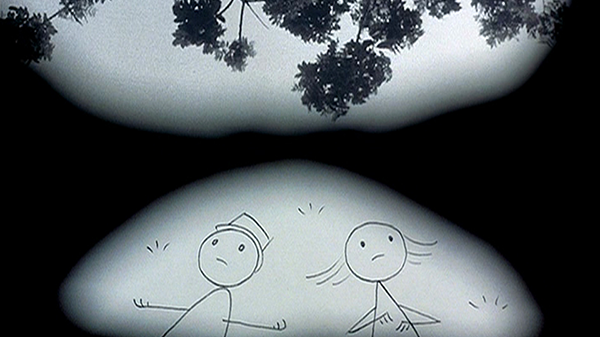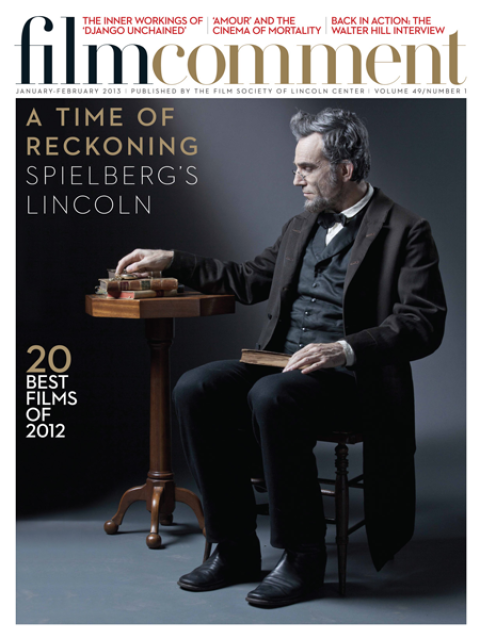
Consuming Spirits
There has never been more entertaining and ambitious animation available to the curious than there is right now. Thanks to the advances and ever-increasing availability of digital animation technology, work is being created in a seemingly unlimited number of styles in all corners of the world, and far more is available online than you would ever have the time to watch. (The website cartoonbrew.com is a helpful portal to animation history and recent studio and independent work.) What’s more, with the pervasiveness of digital effects, audiences are effectively seeing more animation than ever, whether they are aware of it or not. Of the 20 top-grossing films of 2011, six were animated features and all but a handful of the rest were heavily dependent on CG effects.

Le Tableau
Despite this, animation remains a rather vaguely defined, misunderstood, and underappreciated form. With motion-capture technology and digital rotoscoping now providing “shortcuts” to more traditional forms, a debate over the very definition of animation has been ignited among practitioners, academics, and even those charged with handing out year-end placards and statuettes. Also, consider that of the 21 films short-listed for Best Animated Feature for the 2012 Academy Awards, barely half have had any sort of theatrical distribution outside of New York and the other major markets. The list of films that have received formal distribution is dominated by studio fare, a fact that doesn’t help to alter the perception that animation is primarily for kids.
It’s Such a Beautiful Day
Kudos, then, to the New York–based GKIDS (Guerrilla Kids International Distribution Syndicate), which effectively solves this problem by specializing in international work, much of it equally at home in children’s film festivals and art houses. Produced in Spain, the sultry, sexy, music-filled romance Chico & Rita didn’t appear at many kids’ fests, but it is one of the best adult-oriented animated features in recent memory, artfully capturing the nightclub milieus of Forties and Fifties Havana, New York, and Paris. It received an Oscar nomination for Best Animated Feature in 2012. Although more suitable for children, GKIDS’s trio of French releases—A Cat in Paris (by Jean-Loup Felicioli and Alain Gagnol), Le Tableau (Jean-François Laguionie), and Tales of the Night (Michel Ocelot)—display a level of collective sophistication and wit that’s frankly absent from the vast majority of American animated features.

A Cat in Paris
All three films have relatively unconventional narratives. A Cat in Paris (nominated for an Academy Award in 2012) features a cat burglar assisted by a neighborhood feline and ends with said thief romantically attached to the single-mother detective tasked with investigating his crimes. In the fanciful Le Tableau, class distinctions are represented through witty visual corollaries: the aristocratic “Alldunns,” depicted in completed paintings; the partially completed “Halfies”; and the lowest-class “Sketchies.” There are also some scene-stealing appearances by a cheeky and voluptuous nude that you would never find in an American film. Tales of the Night employs elegant silhouette animation that well serves a series of deceptively simple, exotic fairy tales. Each tale materializes out of the banter between an aging artist and his two young assistants as they conjure stories that all end with wonderfully ironic twists.

Alois Nebel
Another example of animation aimed specifically at adults, the Czech feature Alois Nebel has also received limited play in the U.S. Set in 1989 in the then-Czechoslovakian Sudetenland, the film follows a withdrawn dispatcher at a remote train station whose solitude is disrupted by haunting memories of the expulsion of the German population in the aftermath of World War II. Director Tomás Lunák’s stark black-and-white rotoscoped palette sets the mood with a specificity that matches that of any live-action film.

Wreck-It Ralph
Though most studio features appear to have been cobbled together by marketing departments, it would be a mistake to dismiss Hollywood’s entire animation output. Pixar’s Brave, Laika/Focus Features’ ParaNorman, Aardman Animation/Sony’s The Pirates! Band of Misfits, and Disney’s Wreck-It Ralph are entertaining reminders that studio films with sophisticated, nuanced scripts and well-realized characters can be calibrated to appeal to both children and adults. (John C. Reilly’s Wreck-It Ralph is one of the best voice characterizations in memory and demonstrates the benefit of casting according to character as opposed to celebrity.)

The Flame Alphabet
Most inspiring are the growing number of DIY filmmakers who, via the Web or self-distribution, are finding audiences for their work. Don Hertzfeldt’s It’s Such a Beautiful Day, Stacey Steers’s Night Hunter, Erin Cosgrove’s “trailer” for the Ben Marcus novel The Flame Alphabet, and Nina Paley’s This Land Is Mine represent a tiny but tantalizing sample of the diverse array of ambitious recent short work out there. Finally, Consuming Spirits, Chris Sullivan’s dark, humor-inflected portrayal of three characters in a small rust-belt town, represents filmmaking at its most heroic. Featuring virtually every non-digital technique in the book, this 136-minute film took 15 years to complete and received a two-week run at New York’s Film Forum at the end of 2012 after a year on the festival circuit.









